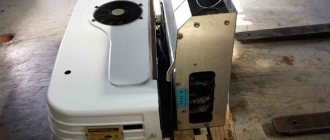The group is a reliable supplier of Elinzh, Thermo King, H-Thermo, Carrier refrigerators for commercial vehicles. We install refrigerators on commercial vehicles, service refrigeration equipment and provide professional advice to vehicle owners. Also in our store you can buy high-quality spare parts for all popular refrigerators. The choice of refrigerator depends on the volume of the body that needs to be cooled, the required freezing speed, and the minimum and maximum permissible temperatures. The type of van or trailer on which the refrigeration unit is mounted, as well as the degree of insulation of its walls and ceiling, also matters. It is also worth considering that the more powerful the cooling unit, the more fuel it consumes.
Therefore, it is necessary to choose a refrigerator that is exactly enough to cool the body of your van. So that you can comfortably transport perishable goods by choosing the most effective price solution when purchasing refrigeration equipment for your car.
Refrigerator prices
The cost of refrigerators directly depends on the technical characteristics and installation method. Also, the price depends on the brand and what price segment this manufacturer belongs to. To make it easier for you to navigate and choose a refrigerator in accordance with a certain budget, we have developed a table that shows the minimum prices for refrigeration units from all manufacturers presented in our catalog.
| Refrigerator manufacturer | Cost, from |
| H-Thermo | 166000 ₽ |
| Rime | 108000 ₽ |
| Thermo King | 285000 ₽ |
Types of refrigerators that can be purchased at Business Auto
(Depending on the temperature in the body)
- Class A. From +7°C to 0°C – used for transporting fruits, vegetables, meat, etc.
- Class B. From +7°C to -10°C – intended for transporting dairy products, fish, seafood, etc.
- Class C. From +7°C to -20°C – set for transportation of frozen products (meat, fish, vegetables, fruits);
- Multi-temperature - the car body is divided into several compartments, in each of which you can set the desired temperature.
In the “cold” category in our online store you can choose a refrigerator that provides only sub-zero temperatures. The line of “heat/cold” refs includes refrigeration units that are adjusted to temperatures from 0°C to +7°C and from -20°C to +7°C.
Installation types:
- Nakryshny.
The equipment is compactly installed on the roof of a car. The refrigerator has virtually no effect on aerodynamics due to its small thickness and streamlined shape - Frontal.
The installation is located above the driver's cabin, which does not affect the aerodynamics of the van. - Universal.
In our online store you can order refrigerators that can be installed both on the roof and at the end of the van.
Installation of refrigerators on cars
There are various design options for cooling systems in refrigerators:
- Direct drive system. This option is suitable for installing a refrigerator on Gazelle and other medium-duty trucks with a working cubic capacity of up to 50 cubic meters. for transporting frozen products, since the compressor uses the resource of the car engine.
- Eutectic plate technology. This system uses special battery plates that accumulate cold during recharging from an outlet (about 8-10 hours). During the transportation of cargo, the necessary microclimate is maintained (for example, down to -30 ° C) for up to 14 hours. The price for installing a refrigerator fully justifies achieving the lowest possible temperatures during the working day in conditions of regular opening of doors for display of goods. Using eutectic plates, it is rational to cool small and medium-sized trucks with a body volume of up to 30 cubic meters.
- Autonomous type of cooling system. This is the most expensive option for installing a refrigerator on cars at a price that will be best justified for large trucks whose length exceeds 6 meters. The technology involves the use of a diesel generator independent of the engine to operate refrigeration and heating systems. With its help, you can achieve stable and uninterrupted maintenance of both low (up to -28 ° C) and relatively high temperatures (+12 ° C). The optimal volume of the body chamber for an autonomous system is from 30 to 85 cubic meters. Similar design solutions for trucks are offered by the South Korean manufacturer Dongin Thermo.
Technical indicators
The machine in question is excellent for use if it is necessary to maintain a certain temperature regime - from +5 to -21 degrees. The Gazelle car (refrigerated truck) is produced on several chassis, which allows you to select a vehicle for specific needs and requirements.
The refrigerated van is made of sandwich panels that are mounted into a single structure. Its internal part is insulated with heat-insulating materials, for example polystyrene boards, and sheathed with sheets of food-grade stainless steel. The outer part of the booth is finished with metal sheet material coated against corrosion.
There are two versions of the van, depending on the required temperature indicators. The modifications differ in wall thickness: 500 and 100 mm, respectively. The first option allows you to keep the products chilled at a temperature of 0-5 degrees. The second design makes it possible to reduce the readings in the working chamber to –20 °C.
Installation of refrigerators on Gazelle
In all types of refrigeration equipment in cars, special attention is paid to the heat capacity of the body. That is why it is necessary to achieve the highest possible level of thermal insulation. To do this, before installing the Elinzh, Dongin Thermo and TerraFrigo refrigerators on the Gazelle, you should prepare the body part. As a rule, sheet metal (stainless steel or aluminum) is used for cladding, and polyurethane foam or polystyrene foam boards up to 10 cm thick are used for internal cold retention. Moreover, all joints are carefully sealed with airtight seals to avoid the appearance of cold bridges with high thermal conductivity. In order to install a refrigerator on a Gazelle, it is recommended to contact experienced professionals who can guarantee high-quality services and use the most modern equipment.
How to transport perishable goods: a review of refrigeration units for vans
In the summer heat and winter cold, these units on the body superstructures of cars and semi-trailers are equally in demand: perishable goods always need a given temperature.
Valentin Ozhgo
The nomenclature of the so-called perishable goods can be listed for a long time, as well as the manufacturers of such equipment. Our customers ask us to install only a reliable unit. There are such: according to the results of last year, the rating list of installed installations for specialized vehicles included only a few companies, which for the sake of fairness we will list in alphabetical order: Carrier (USA), Dongin Thermo and H-Thermo (Korea), TerraFrigo (Russia), Thermo King (USA), Zanotti (Italy), Elinzh (Russia).
The Elinzh S2 refrigeration unit is suitable for installation on cars of various brands.
All machines with direct drive refrigeration and heating units (HU), an autonomous unit or vertical equipment in their PTS have o. Most often, direct drive units are mounted on refrigerated trucks. These are mainly light commercial vehicles (LCVs).
Hypermarkets are actively developing online trading, and with it, they are developing a small fleet of refrigerators and a network of service centers for servicing such equipment in their locations.
Now the market is making up for last year’s shortfall in the production and sales of “refs”, when sales in April-May in physical terms decreased by 29% compared to 2022. As Pavel Syvan, key account manager at SIV Transkholod, told Avtopark, the market is recovering, “in four months, organizations and individuals purchased 19% more cars with refrigeration units than in the same period last year.”
EVERYTHING STARTS SMALL
The demand for equipment with CED has upended the established rules: megacities have demanded a small fleet of refrigerators - light commercial vehicles - to suit the current realities, actively expelling waste trucks from the city limits. In the next two or three five-year plans, our megacities plan to switch to full electric drive.
Thermo King V800 MAX 50 refrigeration and heating unit as part of a van on a MAN TGM18 chassis.
Retailer Magnit ordered 530 of these cars. By the way, in the fall of 2022, the first-born of the electric traction segment of urban distribution vehicles appeared in Russia: at the request of the Magnit network, the engineering company Drive Electro developed the Moskva electric truck, which our publication has already talked about (see “Autopark” No. 8/2020). On the front wall of the insulated body, the developers installed the latest electrically driven Carrier Xarios 8. This equipment has increased efficiency, three times the cooling capacity, and also a very low refrigerant charge level compared to the current Xarios 600 version.
Thermo King announced the release of its E-200 all-electric refrigeration unit lithium-ion battery pack, which has capacity to provide continuous cooling even when the driver stops the vehicle to unload, rest, or turns off the engine for longer periods.
The new Carrier Xarios 8 unit with a power of 5500 W is designed for vans with a volume of 20 to 45 m3.
However, in the Russian urban distribution market such equipment is still a novelty; retail enterprises and specialized fleets are content with classic refrigerated trucks with direct drive. These are mainly vans based on Lada, UAZ, Gazelle, as well as LCVs of a number of foreign brands, including those manufactured at Russian factories. The engine compartment of such machines allows you to place a compressor there and connect directly to the internal combustion engine pulley through a belt drive. This design solution occupies the largest niche for the installation of chemical dispensers in service centers and specialized enterprises - 60% last year.
If the Ulyanovsk refrigerated semi-truck “Profi” is still in its infancy, then the circulation of the Lada family of this commercial version is growing. Several specialized enterprises immediately took up the task of converting small “commercial” vehicles into refrigerators. The Lada Largus Prima, which began to be manufactured from Nizhny Novgorod, was added to the VIS passenger car that was already familiar on the streets.
This is a significant addition to the family of small-capacity refrigerators with a refrigerating chamber volume from 2 to 6 m3, ranging from the regular Lada Largus refrigerator to the Kub, Roof and Prima series based on Largus. Currently, sales of the mentioned models are growing steadily.
Promtech uses refrigeration and heating units made in Russia, Italy and Israel on its small cars, but is ready to listen to the client’s whim.
Prima, in terms of the volume of a cargo van made of aluminum profiles, sandwich panels made of extruded polystyrene foam 50 mm thick and composite material 1.5 mm thick, turned out to be 6 cc. For urban delivery, this internal volume is just right: on average, during one trip along the delivery route, a small car carries from 300 to 500 kg of payload, but according to its passport it can carry 750 kg.
Promtech has come up with such a refrigerated “heel”: it’s fast in operation, easy to maintain, and the cost of ownership is attractive even for a novice entrepreneur.
Promtech uses units made in Russia, Italy and Israel on its vans, which are designed for different financial capabilities of the consumer. The test versions included CCDs with equipment from many manufacturers (H-Thermo, Thermo King, etc.), but for now we settled on the mentioned three manufacturing countries. Russian Arctic installations fall under the budget option, Italian Zanotti - more expensive.
Zanotti refrigeration units of the Zero, SFZ and UFZ series are designed to maintain climatic conditions when transporting chilled and/or frozen food products in insulated vans of vehicles with a volume of 4 to 41 m3.
Israeli Alex Original units are the “golden mean” with an attractive price-quality ratio. They are more expensive than Russian ones, but cheaper than Italian ones and meet the needs: efficient equipment, thanks to a good compressor, a powerful evaporator and reliable fittings, quickly cools the van down to -20 ° C. Another factor that is captivating is that few people know about it: Israel supplies all components with guaranteed high quality to us at an average price, which then forms the ratio of cost and quality of the refrigerated truck itself that is most acceptable to the Russian consumer. In addition, Israeli units, when serviced and repaired in service centers and specialized repair shops, are cheaper than other imported analogues.
Almost simultaneously with the publication of this issue of the magazine, together with the launch of a new version of its insulated van Peugeot Partner with the well-known all-electric refrigeration unit Carrier Neos 100. Depending on the version of the body length (4380 and 4628 mm), its thermal insulation materials (cladding with polyurethane foam inside or a sandwich panel) and thermal conductivity coefficient, in the first case a temperature regime is created from –10 to +12 °C, and in the second - from –18 to +12 °C. The refrigerator is additionally equipped with a stand-by parking section for 220 V.
The Carrier Neos 100 ceiling evaporator for a 2.7 cc body is just right in terms of power, and there is even a reserve, but the condenser had to be installed on the roof.
AUTONOMY WILL STILL RULE
Everything is going to the point that this year the statistics of HCUs mounted on vehicles with autonomous drive will go up: the leading Russian retail company X5 Retail Group ordered 440 trucks with autonomous Carrier S refrigeration units for 2022. Over the past two years, this is the largest supply of units of this class to the Russian market.
Refrigerators based on medium-tonnage DAF and Isuzu chassis with autonomous S 750R units are already being shipped to the customer. At the same time, as Avtopark was told by the distributor of transport refrigeration equipment Carrier, when executing the order, the operating conditions of the equipment in different climatic zones were taken into account.
The Thermo-King B-100 is a new line of all-electric units for light trucks and vans.
While the autonomous S 750 refrigerator with its own diesel engine and parking electric motor is well known to both drivers and mechanics in the regions, the Arctic version of the Nordic is less common. The editors of Avtopark decided to find out in more detail about the northern versions of HOU. It turned out that 25 through-loading couplers are being prepared for operation in the cities of Salekhard, Surgut and Tyumen. Ten of them come in a special “Arctic” version of the S 850 Nordic, their release is scheduled for August.
The “Arctic” version was specially created for Russia with its low temperatures. The main difference is that the units in heating mode are three times more powerful in performance. Agree, the Arctic 10,600 W versus 3360 W in the regular version of the S 850 is much more advantageous. The unit is equipped with electric heating elements powered by the parking module, and an additional heat exchanger in the evaporator housing, where antifreeze from the HOU engine releases heat into the space of the van.
True, for drivers and mechanics working in Yakutsk or Murmansk, having another engine in their car in winter does not add joy. Those who worked in those regions will understand. Therefore, the developers had to work hard on the Nordic version, adapting the chemical dispenser to the critical temperatures of the North. Thanks to the use of a special glow plug control system, starting in cold weather has become easier and a good third faster.
Electric heating of the fuel filter and fuel lines has appeared, and for the winter the engine of the refrigeration and heating unit will be filled with special antifreeze and oil that do not freeze even at –50 °C. The installation was also equipped with a parking module for operation from the electrical network during parking or preparing the van for work.
There is already experience in operating Nordic in Russia: 25 vehicles are equipped with the Arctic version of the chemical dispenser. If there were complaints, it is unlikely that new orders for such execution would have been received. Let’s hope that the “refrigerators for the Arctic” from the current batch will also behave with dignity. True, in northern frost conditions it is very difficult to foresee anything: testing and accumulated experience in the operation of equipment is good, but real operating conditions in the critical temperature zone are sometimes unpredictable.
Nikolay Arkhipov, General Director of Promtekh LLC
Passenger refrigerated vans are convenient due to their dimensions, low cost of ownership, quick payback and the most common availability for driving: it is enough to have category B on your driver’s license - get in and go. There is no need to look for drivers with category C, who are now in short supply. To master the care and operation of a refrigeration unit, one hour is enough: during this time the mechanic will tell you, show you and take the test. Tested in practice. In our fleet there is a Prima car with a seven-cc body, one of the very first ones made on the basis of Largus. The refrigerator has been in operation since February 2021, travels all over Russia, there are no complaints about the chassis, engine or refrigeration equipment itself. The longest trip was from Nizhny Novgorod to Kazakhstan with half a ton of cargo. The driver is happy, and so is the mechanic: the refrigerator is comfortable, easy to drive and does not cause any problems with breakdowns. There is another plus - it is economical, the average consumption is nine liters per hundred square meters.
Pavel Syvan, Key Account Manager
Immediately inquire about the cost of ownership of the unit. It would be a good idea to request a map of service centers. If they are off to the side or far from the routes of your refrigerators, then it is better to look for another dealer and manufacturer with a more extensive network of repair and maintenance of such equipment, including the presence of mobile teams. If such a center offers a service contract, work with that supplier. Don’t forget the necessary attributes: no matter how reliable and productive the unit is, an inexpensive curtain for the doorway of the van will help save the temperature during loading or frequent unloading along the route. And don’t forget about temperature data recorders, door opening sensors, telematics systems for monitoring cargo and performance indicators of the refrigeration unit: there are little things in transportation.
The editors recommend:
Why do piston rings stick and how to prevent it?
A traffic police officer searched my car: did he have the right to do so?
Russians may be left without foreign cars: Western automakers have stopped supplying cars to our country
A ship that was transporting cars to Russia was detained in France
Half of the car factories in Russia have closed
- Refrigerator
- van
Discussion Cancel
Distinctive character of Gazelle
The basic equipment includes power steering, an adjustable seat and a disc brake system. The car presented to your attention corresponds to the Euro-4 environmental class.
Trucks come from the factory with rear-wheel drive, but manufacturers have gone further and developed all-wheel drive on the latest models.
A big advantage of a Gazelle with a refrigerator is the presence of an additional stove in the booth and cabin. The manual transmission is usually five-speed.
Main settings
Installation of refrigeration equipment on a Gazelle requires preliminary consideration of load capacity and temperature fluctuations within the required limits. Depending on the main base, the carrying capacity and dimensions of the vehicle are:
| GAZ-3302 | Valdai | "Gazelle Next" | |
| Length (m) | 3,0 | 3,6 | 3,0 |
| Width (m) | 2,0 | 2,3 | 2,0 |
| Height (m) | 1,9 | 2,0 | 1,8 |
| Load capacity (t) | 1,0 | 3,5 | 1,5 |
It is quite possible to order such a “Gazelle” (refrigerated van) based on an individual project. There are models equipped inside with several chambers in which different temperatures are maintained.
Refrigerators / Refrigeration and heating units (HOU)
In "TCTTM", which has a quality certificate "FRC" . But most importantly, we have a unique, best press in Russia for the production 15x3 meter canvas . Due to this, the walls of our vans have a minimum number of joints and, as a result, maintain temperature well.
Purpose of use A refrigerated vehicle is intended for transporting food products at low temperatures in order to ensure the required duration of their storage.
Design featuresStructurally, a refrigerated semi-trailer can be divided into three large components: the chassis, the van body with isothermal characteristics and the refrigeration unit itself.
1) The chassis is the main component of the refrigerator, if we consider it as a means of transport. It is the chassis that determines the carrying capacity of the equipment, the type of engine (for a car), suspension or shock absorbers (for a semi-trailer), the number of axles, tonnage and dimensions of the van body.
2) In this case, the van body must fully comply with the selected chassis - both in size and fastening parts, in addition, it is necessary to meet the necessary parameters for the thermal conductivity of its walls.
3) As for the refrigeration unit, this is the refrigeration unit itself, which provides the required temperature regime inside the refrigerator.
How to choose the right HOU It is extremely important that all the constituent elements are in full compliance both with each other and with a certain temperature regime in the body. In the cars section of our website you will find standard sizes of bodies designed for specific chassis, and in the semi-trailers section, the standard sizes of these components are presented, respectively. In addition, you need to determine the thickness of the walls of your van, based on isothermal requirements.
The overall dimensions of the body will help to calculate the useful volume inside it. Based on this indicator, a refrigeration unit is selected that should provide the required temperature.
Classification Referring to the ATP Europe rules for the transportation of products with a short shelf life, a refrigerated vehicle is considered to be a vehicle that has an isothermal body and a refrigeration unit that allows, taking into account an average temperature of 30 ◦, to maintain the temperature inside the unloaded van as follows:
Class A – maintains temperature within + 12…0◦ C (inclusive);
Class B – maintains temperature within +12…-10◦C (inclusive);
Class C – maintains temperature within +12…-20◦C (inclusive).
At the same time, when certifying refrigerators, the following identification marks are accepted:
FNA – normal, class A
FRA – reinforced, class A
FRB – reinforced, class B
FRC – reinforced, class C
You can find out more about the product you are interested in from our managers.!
Preparation for installation
Most often, installation and repair of refrigerators is carried out by specialists. However, the installation of refrigeration equipment on a Gazelle can be done with your own hands if you have certain skills and tools.
Before you begin the installation process, you will need to purchase the following items:
- compressor unit;
- automated control unit for refrigeration systems;
- blocks for indoor evaporator and outdoor condenser;
- electrical wiring;
- connecting elements and refrigerant pipes.
In addition, you need to stock up on sealant, fittings, material that will mask the mounting casings, and a tool for drilling holes and clamping the fixing parts.
Main works
The first step is to install the compressor. You will need to attach a special bracket to the power unit. The device is aligned taking into account the belt drive so that nothing interferes with the movement of the pulley. Then low and high pressure hoses are mounted on the compressor. They are crimped with fittings, the excess parts are cut off. After this, the pulley is connected to the compressor and motor. The maximum play should be within 6 mm.
Next, the evaporator and condenser are attached through pre-drilled holes where the refrigerant pipes will pass. It is recommended to make rigid bookmarks at the attachment point, which will prevent damage to the van from vibrations. The evaporator is placed inside the booth, and the condenser, respectively, is placed outside. Compressor hoses are connected, all clamps are thoroughly tightened.










